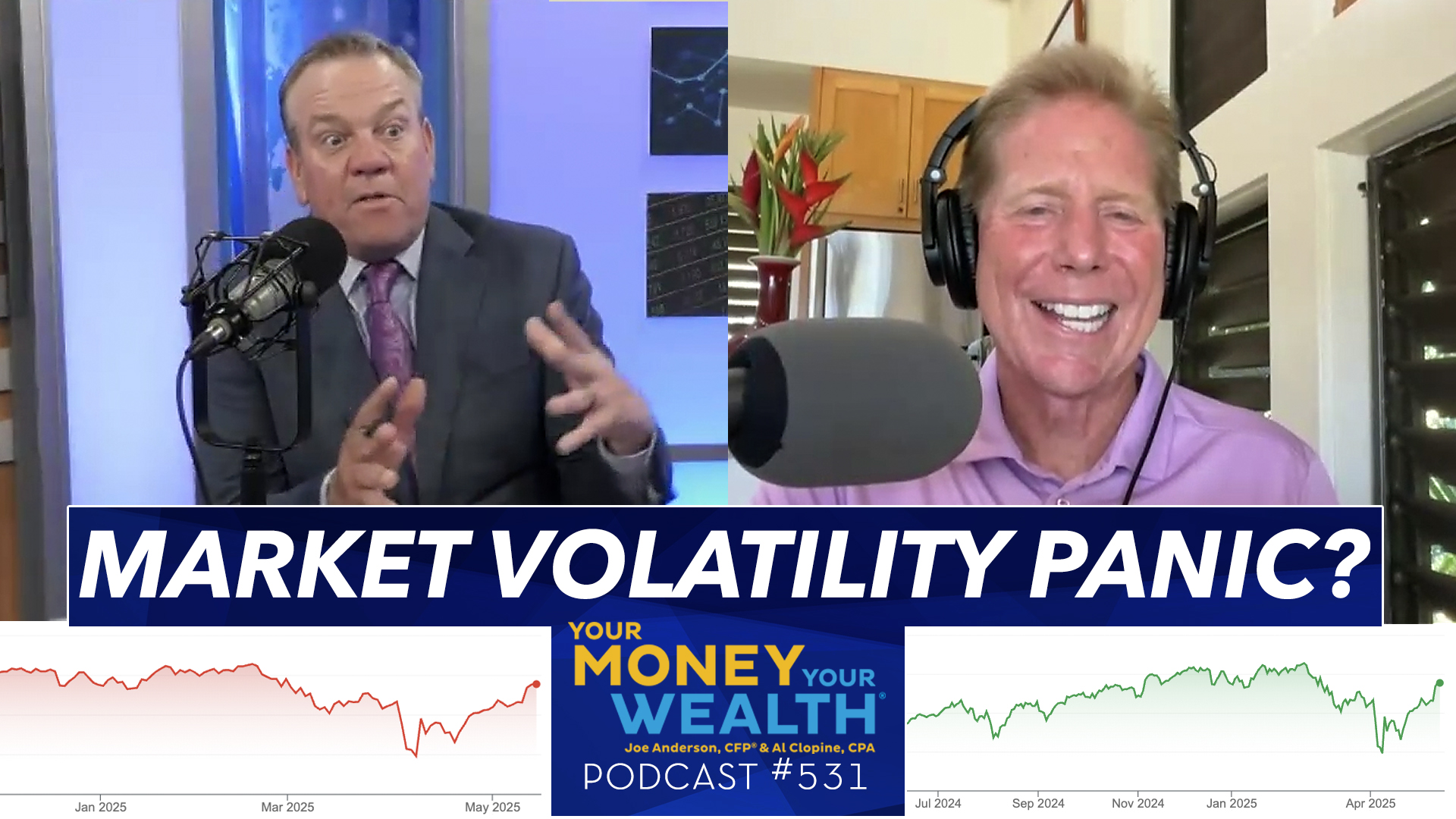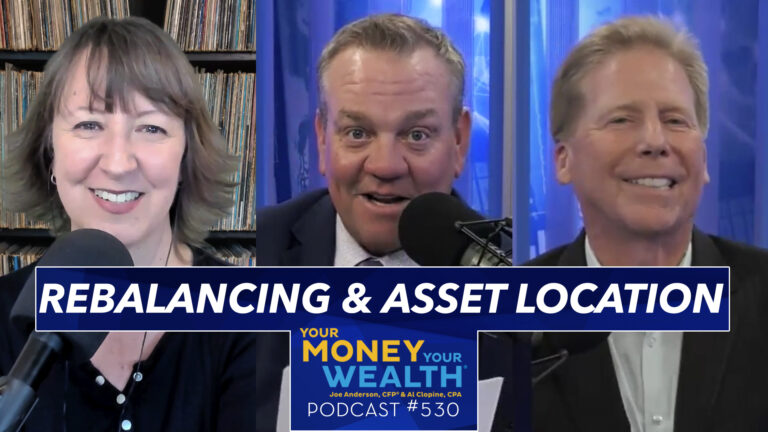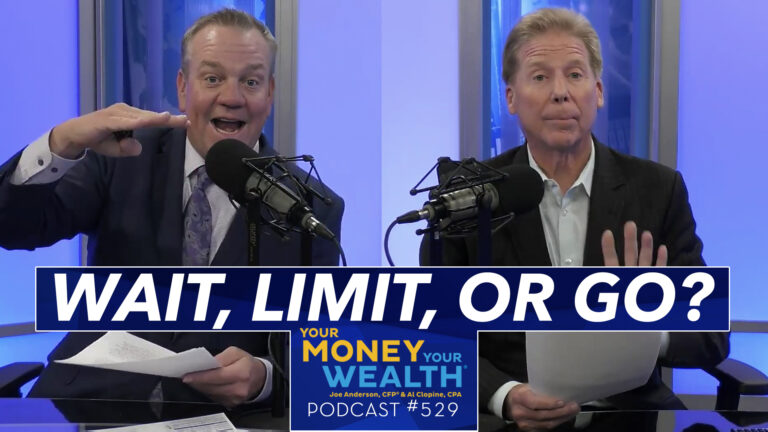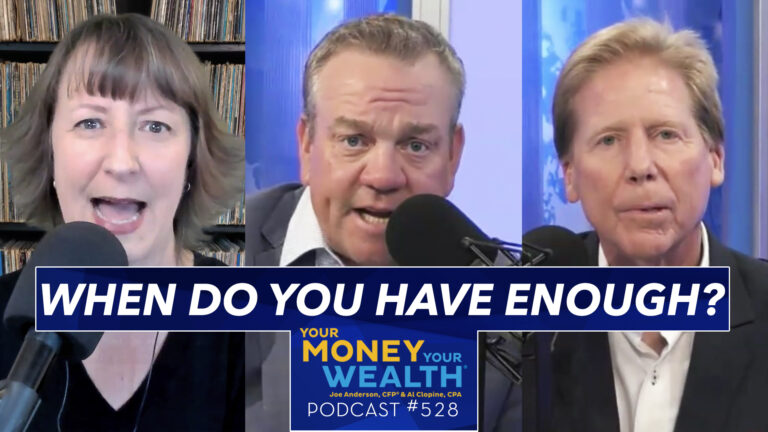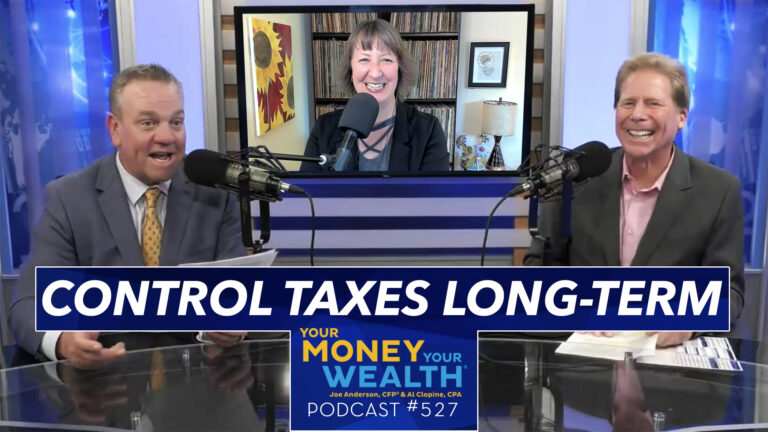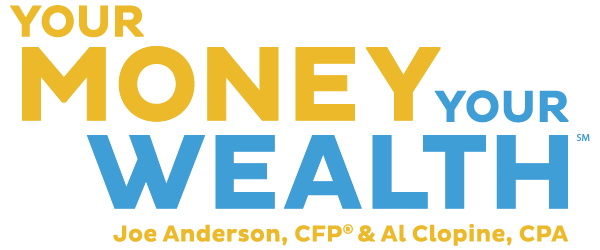Tariffs killed Carl’s investment portfolio and left him wondering if he should claim Social Security early. Kelly and Steve in Pennsylvania ask for a three-fer spitball: when to claim their Social Security, whether they should contribute to Roth or convert to Roth for that lifetime tax-free growth on their investments, and if they’re on track for Kelly to retire in three years.

Show Notes
- 00:00 – Intro: This Week on the YMYW Podcast
- 01:21 – Tariffs Killed My Portfolio. Should I Claim Social Security Early? (Carl)
- 10:14 – Watch The Retirement Course: Can You Hit a Hole in One? on YMYW TV, Calculate your Free Financial Blueprint
- 11:13 – When Should We Claim Social Security? Roth Contributions or Conversions? Are We On Track for Retirement? (Kelly & Steve)
- 25:00 – Download the Key Financial Data Guide, YMYW Podcast Outro
Guides | Blogs | Educational Videos | YMYW Newsletter | Subscribe on YouTube
Watch today’s podcast episode on YouTube
Transcription
(NOTE: Transcriptions are an approximation and may not be entirely correct)
Intro: This Week on the YMYW Podcast
Andi: Quick programming note before we get started: over the next several weeks, I’m moving to Australia, video producer Aaron is biking through Croatia, Big Al is vacationing across Japan and Europe, and Joe will be enjoying Arkansas and Minnesota! In our absences I may share some encore episodes, compilations of previous content you may have missed, and some short episodes like this one, but everything will be back to normal in July. Pretty sure.
Tariffs killed Carl’s investment portfolio and left him wondering if he should claim Social Security early. Joe and Big Al spitball for him today on Your Money, Your Wealth® podcast number 531. Kelly and Steve in Pennsylvania ask for a three-fer spitball – when to claim their Social Security, whether they should contribute to Roth or convert to Roth for that lifetime tax-free growth on their investments, and if they’re on track for Kelly to retire in three years. To ask your money questions or to get a Retirement Spitball Analysis of your own, check the links in the episode description – you’ll see one that says Ask Joe and Big Al. Click or tap that link, and before you start your ask, make sure to watch my video telling you how to make your spitball a good one. Then send us a voicemail or an email. I’m Executive Producer Andi Last, and here are the hosts of Your Money, Your Wealth®, Joe Anderson, CFP® and Big Al Clopine, CPA.
Tariffs Killed My Portfolio. Should I Claim Social Security Early? (Carl)
Joe: Alright, we got a call, or Email from Carl. No location from Carl here.
Andi: No, he emailed info@purefinancial.com and he did not follow the rules.
Joe: Got it. He goes, Hey guys, just love your shell. Drink of choice is now any IPA and I drive a GLE three 50. I’m 63, retired. My wife is 59. Still works. We’re on our way to a good retirement with $1.2 million in Roth IRAs, $1.8 million in traditional IRAs. Also have investments close to 500,000, returning at 7.5% per year. That’s a pretty good return. My wife was planning to retire Q2 of 2026, but because of the tariffs. We’ve seen our portfolio, Roth IRAs and 401(k)s drop over $300,000. I’m thinking about starting my Social Security benefits. Is this a bad idea? Also, our net budget is 96,000. Own our home outright, have no car payments, but have a HELOC if needed. Carl Benz. That is Benz. Is that like a Mercedes-Benz?
Andi: That is what he is driving. His GLE 3-fiddy.
Joe: GLE 3-fiddy. Well, I wonder if it’s returning 7.5% per year. I bet. But good old Carl wished he had all his money in the seven point a half percent per year bucket,
Al: or maybe that’s what it was before the tariffs.
Joe: No, I, bet it’s some fixed triple. Something that’s gonna blow up on him at some point, right?
Al: Private credit maybe.
Joe: Yeah. Could be. I don’t know.
Al: Yeah.
Joe: All right. So what do you think you, so he, his portfolio’s dropped $300,000 a year or 300,000, so he’s freaking out a little bit. He’s 63 years old.
Should he take his Social Security benefit? They’ll give him about $3,000 a month.
Al: Yeah. So f first of all, just to do a little bit of math, he wants to spend 96,000 per year. He’s got about three and a half million if, and he is got, um, he’ll have 33,000 coming Social Security if he starts it now.
So even without Social Security, Joe, it’s a 2.7% distribution rate, which is a, good rate, I think at eight, six. Yeah. But his wife is still working. Right. I don’t
Joe: think he needs any of the money.
Al: Well, I, suspect he’s, but she, wants to retire in Q2 of 2026. I think that’s what he’s probably getting at is should I take it when she retires?
Because our portfolio is down so much and I’m just gonna be taking more from it. I think that’s what he is getting at. And I’m gonna say he doesn’t need to, I think there’s still plenty of assets. He’s gotta have some safe assets to draw the money from while the market is declining, like bonds or what, whatever his fixed income is at 7.5%, that kind of thing.
But no, I don’t think he needs to. He can. He certainly can if he wants to, but I don’t think he has to.
Joe: Yeah, I think this is the problem with people that don’t necessarily have a true drawn out strategy, is that alright, things get a little bit shaky and what’s my, you know, parachute, should I go ahead and grab Social Security?
Here’s a, here’s the probe of taking Social Security early. Is that you’re, it’s a less distribution from the overall portfolio, so you’re saving more of the portfolio long term. The downside is, you’re locking in a lot lower rate for the rest of your life. So do you feel that the market is gonna continue to decline for a certain time period and never recover?
Or are you taking so much from the overall portfolio if he was taking like 7%, 8%, or 9% from the portfolio and trying to bridge the gap to Social Security? It’d be alright. Well now that’s a little bit too much because as the market’s declining and you’re taking that big of a draw from the portfolio, it’s hard to recover from that big of a decline.
I mean, we’re seeing declines in the market, but you’re taking 2% out and I don’t think he’s taking 2% out today. I think he’s taking 2% out in 2026, which is another 12 months from now. And if you look at the volatility of the market, I’m not sure when he sent this in, but it might have been, you know, alright, well here, well what’s going on in the overall markets that this is a, short period of time, right?
The markets blip. You’re gonna have down years, you’re gonna have. Goodyear, 70% of the time the market’s gonna go up. So I wouldn’t make a has decision to say, Hey, because of the markets are volatile today, I wanna take my Social Security benefits. You still have to weigh this thing out. And I think Carl has a low distribution rate where I still think it makes sense for him to continue to wait until whatever plan, you know, he, decided on, you know, prior to the volatility of the overall market.
Al: I think you bring up a good point, Joe, which is a, market decline or market increase doesn’t necessarily affect your plan, right? You should already have your plan. If the market goes up, great, you can pull a little bit more outta the stocks. If it goes down, well, that’s too bad, right? But you pull money outta your safe money, your bonds, you let the stocks recover.
It doesn’t really change anything else, per se. Especially when you have a low distri distribution rate like this 2.7%. You’ve got the flexibility to, To stick with your plan, whatever it may be.
Joe: Yeah, I, think he needs to be thinking about other things at this point. It’s like, alright, if the markets are down, how should you be rebalancing the overall account?
How do you manage the risk? Should you be thinking about, you know, tax loss harvesting opportunities? If he has non-qualified accounts, should he be thinking about Roth conversions? Should he be thinking about more higher strategic things that will benefit ’em long term? By claiming Social Security early, it’s kind of a kneejerk reaction.
I get it though. It’s like, okay, I’m seeing my portfolio drop $300,000. I don’t wanna touch my portfolio anymore, or I don’t wanna take as much from the portfolio, so why don’t I just take this guaranteed income source of Social Security and then that’s gonna save that portfolio because I’d like to see that balance at a certain level.
Right. Hey, I have two and a half million dollars or three and a half million dollars. Now that’s worth 3.1, 3.2. It’s like, wait a minute. I just lost 300,000 in a couple of weeks. That’s way too much. You know, where’s this thing gonna go? And so, hey, let’s, that’s why people go into cash, right? It’s like, alright, I gotta stop the bleeding.
Or they do other things like this that could hurt them long term by, you know. Maybe giving up some, extra cash on the table, depending, you know, of course, what his life expectancy is.
Al: And of course the second part of this is, if you take Social Security early, not only is it a lesser amount for you, but one of you will probably outlive the other one.
Right? And so then you’re decreasing your spousal’s, your spouse’s benefit, in the future. So, yeah, unless I, you know, I think we’d like to say, Joe, that unless you really need the cash, it’s better to wait. Now if you have health issues, or you both have health issues and you wanna take it early, great.
Or if you just. In this particular case, it’s, not like it’s gonna kill ’em because they got plenty of assets. So it’s, almost a personal choice, but I, wouldn’t do it. I think I’d, much rather wait and get the higher benefit.
Joe: Yeah. It doesn’t matter really for him. If sometimes, people write in and, Hey, I wanna take my benefit right away because I want the extra cash right now so I can go on vacations and I can travel and I can do different things while I’m still young and I’m still healthy and blah, blah, blah, blah, blah. It’s like, yeah, then take it. Right. You can run the math all day long and you can look at the break even points that people want, wanna think about, or how much true dollars is gonna come from the system, you know, given certain life expectancy, ages.
But it’s like, okay, well how much money am I actually gonna spend, you know, on travel when I’m in my late eighties versus I’m in my early sixties? You know, I, wanna see the world, I want to do different things, and it’d be great if I had an extra 2030. $35,000, you know, in my pocket to do those things.
Then go for it. Right? Who cares what the number and what, how much are you gonna bleed the last dollar out of the system that you deserve versus, alright, maybe you take a little bit of a haircut, but you enjoy your life that much more. I mean, so I, I think it’s, there’s a dollar in cents side of things, and there’s also the real life side of things.
Al: Yeah, completely agree. I just wouldn’t make a decision just because of the market. I think that’s, maybe that’s what we’re saying. if you want to, and the reasons you just mentioned have a little bit more of spending money right now, then great.
Watch The Retirement Course: Can You Hit a Hole in One? on YMYW TV, Calculate your free Financial Blueprint
Andi: Planning for retirement is a challenge, just like the game of golf. Only 3.2% of retirees have a million dollars in their retirement accounts, and only 1 to 2% of golfers annually make a hole-in-one. Luckily, you don’t need a hole-in-one to win the financial game – but you do need a strategy. This week on a brand-new episode of Your Money, Your Wealth TV, Joe and Big Al show you how to get off the tee, avoid the fairway hazards, and sink the putt to get you through the retirement course successfully. And don’t miss the golf tips, especially for the YMYW audience, from PGA professional Chris Riley! Find the link to watch in the episode description, then calculate your free Financial Blueprint to see if you’re on the fairway for retirement. Input your financial details, and it’ll output a report that tells you how much money you’re likely to need to meet your retirement goals, and actions you can take now to get there. Click or tap the links in the episode description to watch The Retirement Course: Can You Hit a Hole in One? on YMYW TV, and to calculate your free Financial Blueprint.
When Should We Claim Social Security? Roth Contributions or Conversions? Are We On Track for Retirement? (Kelly & Steve)
Joe: Alright, let’s, let’s move on. Let’s go to Kelly. Hello. We would love for you to give us a little spitball analysis. I’m 57, husband 64. I drive a 2017 Honda Accord and he drives a 2017 Toyota Tacoma. I usually only drink on vacation and I like tropical drinks. Yeah, looks like big Al’s got a little tropical drink right behind you. Little Malibu.
Al: Little Malibu. Yeah, that’s right. Yeah. Koloa Rum is the other one.
Joe: What’s the, what’s it? What’s the other one?
Al: Yeah, you got Malibu and then the other one is Koloa Dark Rum.
Joe: I never, heard of that.
Al: Koloa is made here, right on Kauai. It’s actually very popular rum these days across the United States.
Andi: Joe, we were wondering if you were gonna notice and of no surprise. Of course you did. There’s alcohol in the shot.
Joe: There we go.
Andi: Are you much of a rum drinker at all, Joe?
Joe: No. No, I think I had mai tais on my honeymoon and I almost got divorced.
Al: That’s ’cause you had too many.
Joe: It was the end of that. all right.
Al: But you have to be, you kind of have to be an island guy to like rum, I think. Yeah. And you’re not, much of an island guy. You, you’re, you, like Minnesota cold, places, right?
Joe: Yeah. You the army. Little SCHs. Right. Yep. yeah, I get like island fever, I get vertigo last. I was just there a couple, like a couple months ago.
Al: Yeah, I know you were, it’s like, it’s just not for, you, is it?
Joe: I guess not.
Al: Yeah.
Joe: All right, so Kelly’s husband, he enjoys the IPAs and always tries to get something local. All right. He is retired and gets a lifetime pension of just over $4,000 a month, no coal, and my survivor benefit would be $1,600 per month. He’ll be starting Medicare this year. I’m still working, hoping to retire in 2027.
When I turn 60, I’ll be able to stay on his health insurance until I reach Medicare age. We will only need to get dental and vision privately. Once I retire, I make around $80,000 a year. We have no debts and the house is paid off. We plan to stay in this house long term. Our expenses are approximately $6,000 a month, and we do like to travel, so that will increase once I retire.
We are healthy and hope to be able to travel for many, years. Our kids are grown and financially independent. We gotta cash in a high yield savings account, a hundred grand. 401(k)s is 425,000. Roth IRAs, 86,000 Brokerage account, a hundred thousand stocks in crypto. 14 k total is $728,000. Our current plan is for Steve to take Social Security at 67 when I retire.
We can live off this pension and Social Security. My questions are one, when should we take Social Security? Is this a good plan for him to take it at 67 instead of a waiting till age 72? Should I be putting all my 401k contributions into Roth instead of splitting it? Three. Should we do Roth conversions?
If so, when?
Andi: God, this is very specific, is she wants a dart on the dartboard rather than a spitball.
Joe: Yeah, it’s not a spitball here, and you better get a bullseye. This is like written recommendations. I gotta get compliance approval.
Al: Right.
Joe: Thanks so much. For your help. Love the show. Listen to it regularly. Alright. Steve and Kelly. Okay. All right. When should they take Social Security? So, 67. I have no idea why she came up with age 67 for Steve. Um, because Steve is 64, she’s not gonna retire until age 60. She makes $80,000 a year.
Al: Well, that’s because, he’ll be 67 when she retires. Three years from now.
Joe: So when she retires, she wants him to take Social Security.
Well, she’s asking to kinda help plug the gap there.
Al: That’s what she’s asking. Right? And so,
Joe: got it. Okay. So if that makes sense.
Al: Now, if he doesn’t take Social Security, they wanna spend 72,000 a year. They would have 48,000 coming in from his pension shortfall of 24,000. So here’s the math. You take 24,000, you divide it by your total liquid assets, in this case 728,000.
You get 3.3%. That’s, that should be fine. Right? That’s under the 4% that you want when you’re retiring in your sixties. So I’m okay with them not taking Social Security, but again, it’s a little bit like we talked about on, the last question. it’s a little bit more of a personal choice. if, he wants to take it, you know, he’s, that would be another 33,000 of income that would essentially cover their expenses.
Joe: That would save the portfolio.
Al: I would take and save the portfolio.
Joe: Yeah, I think this is such a different case though, because they got 4% coming out. They’re wanting to travel more. They’re very healthy. It’s like, well, if we’re traveling more, we’re gonna spend more. And the other guy, you know, I think it’s, you know, three and a half percent, but then you have taxes in front of that. You’re pushing four. I’d much rather have. Cushion taking the Social Security and then if you wanna travel a little bit, you can take a little bit more. I mean, the, benefit you get an 8% delayed retirement credit for a couple more years. So the longer that he waits, maybe you take it at 68 just to see how that first year goes. And then if it feels like. It, we, might be taking too much. We might be spending too much. You can always turn Social Security on at any month, so instead of a hard 67, it, it’s nice to delay it, especially if they’re really healthy because they’ll, like the higher fixed income three years from now. Or, you know, when, or three years after the claim. So I would test it. I mean, I don’t think there’s a hard, fast rule here. I think it makes sense to take it any time between 67 and 70, but you’ve gotta live your life now that she’s retired, no income’s coming in and just see how you adjust, because that’s why most people take Social Security early, al because they want at least some sort of fixed income coming in.
Al: Right. Yeah, I think that’s right. Anywhere between 67 and 70. I personally would, in this situation, would probably take it at 70 just because just doing the math, it would add almost $10,000 more of income for life. Right. And so that seems like pretty good. But on the other hand, I, it doesn’t, it’s almost more of a personal choice, as you said, and particularly the fact that they want to travel more. The fact that they may be. Thinking they shouldn’t travel ’cause they don’t have the extra income. I, would, I think they’re gonna be fine either way. So in a way I’d kind of rather have them take it earlier and travel if that’s what they wanna do, right?
Joe: Yeah.
Al: But, I think they can, if they wait, they get a little extra income. I think they have enough of a portfolio. Now, if the market’s going down at the same time where they’re pulling money out, that’s not gonna feel good. I guess I kinda like your idea, Joe. Maybe you. Don’t take it initially. Test it out, see how it feels, and then if you want to take it six months, a year later, whatever, go ahead. I like that.
Joe: Yeah. You know, and it’s, this is just kind of like the opposite advice that we gave earlier too. I mean, I, think this is why the, you can’t really have cookie cutter advice. E every situation is so different. Know, I think the first question we had is like, all right, here, the market fell. The market tanked. So I’m going to take my Social Security because I have $5 million or whatever. How much money did that guy have?
Al: I wanna say about three.
Joe: Yeah. I mean it was a ton of money. It was several million dollars.
Al: Yeah.
Joe: It was like, here I want to take it. It was like a knee jerk reaction. Yeah. ’cause of the markets and he got kind of scared or freaked out and it’s like, well no, I mean, if you have a strategy in place, I think for him it probably makes sense to delay it.
Um, he could take it, but he had plenty of cash or plenty of capital, so it didn’t necessarily matter all that much. I think the Social Security benefits to this couple means a lot more to them. Yeah. Not saying that it doesn’t mean. I mean, they don’t have $5 million. Right? They’re like, all of us, they have 700, $800,000.
It’s a really strong nest egg, but they can’t make a ton of mistakes. Yeah. They’re at a three and a half percent distribution rate. So I mean, if the market tank and they’re taking more out, I mean, you’re gonna see that balance, you know, go down a lot more. It’s gonna, it’s gonna affect them a lot more than it would be with someone with millions of dollars.
Al: Yeah, and I will say we, we do get a lot of, questions from people that have millions, but to be really blunt and honest, 700,000 of a nest egg is an amazing nest egg. I mean, that is so far above the average person. It’s ridiculous. So you’ve done a great job and it’s a little bit of a personal choice.
You could take it now, you could take it in between, you could take it at 70. I, think, me personally, I’d probably wait to 70, but the fact that I don’t want you to not travel. So if you’re gonna feel like I can’t travel till I take Social Security, then take it. Right. Alright. And by
Andi: the way, you didn’t give advice earlier or now you spitballed.
Joe: Thank you. Did I say advice?
Andi: Yes.
Joe: Oh.
Andi: It’s been a long day. It’s okay.
Al: Oh, here, Let’s do this. These other ones real quick too. Should the 401k contributions go into a Roth? I would say yes right now. Yes. and should we do Roth conversions? Possibly. But I would say that’s more of a decision when she retires and you take a look at it and, see what makes sense.
Joe: I don’t understand how to figure out the tax rates. Well, let’s help Kelly figure out tax rates. So let’s see. Kelly. Kelly. Kelly. Kelly. Kelly.
Al: So she makes 80,000 a year.
Joe: Husband’s retired. Yep. And he kind of pension of $4,000 a month. So $48,000.
Al: Yeah, so we’ll save by the time you add that up and whatever other little amounts they have from tax, well, it’s probably near the top of the 12% bracket.
Joe: So, you add up 48,000 plus eight, 80,000.
Al: Yeah. One, one twenty eight and then let’s call it two minus
Joe: 30,000. Yeah. For your standard deduction,
Al: right? Puts you, right around 98,000, which is right at the top of the 12% bracket, which, so if
Joe: you go to like the IRS, so the, how the tax brackets work, they’re marginal and I think a lot of people get confused here.
So if you look at married finally jointly, so zero to $23,000. Is that married? Um, yes. Of taxable income is going to be taxed at 10% and then 23,000 3 0 1 or 2 0 1 to 94,300. Is going to be taxed at 12%. So the top of the 12% tax bracket is roughly $95,000 of taxable income. So there’s a standard deduction, which is around 30,000.
So you take your gross income, which Kelly and Steve have of about $120,000. You minus the standard deduction, which is roughly 30,000. So one 20 minus 30 is 90. So out of the $90,000 that Kelly and Steve have coming into the household, the first 21,200 of that 90,000, so let me just round the first $25,000 of the 90 is gonna be taxed at 10%.
The remaining will be taxed at 12%. So it’s stair steps. So some is gonna be taxed at 10, some is gonna be taxed at 12. And then if you had additional dollars above the 12%, those additional dollars would be taxed at 22%. So when we say you want to convert to the top of whatever bracket. Is that, well, you’re still in this bracket and you might jump a bracket.
You might go into a higher tax bracket later, or tax rates might go up, so it might make sense to buy that tax cheap today. So go to the top of the 12, pay the tax, get that money into a Roth. So when you’re thinking about Roth conversions, you wanna look at what tax bracket that you’re in today forecast what tax bracket you think you’re going to be in the future, and then that’s gonna determine your conversion strategy.
And how to kind of determine the amount is just looking at the tax tables that the IRS publishes and then looking at your tax return and looking at taxable income, which in 2024 now is what Line 10
Al: could be. We don’t have the return in front of us. I will, for our engineers, Joe, you, quoted ‘24 rates. So the ‘25 rates is about 97,000. That would be the top of the 12%.
Joe: Oh yeah, that’s right. I did.
Andi: Welcome to 2025, Joe.
Joe: I didn’t know. It was the 24. I thought that was off.
Al: Yeah. Yep. You’re close though. That’s within a few thousand.
Joe: Yeah, those were the 24 rates.
Al: Yeah.
Joe: There you go. I was looking at my Key Financial Data Guide of 2024.
Andi: We’ve got ’em going back to like 2010 or something.
Joe: You can download the Key Financial Guide of 2025.
YMYW Podcast Outro
Andi: Check the link in the episode description to download your copy of the Key Financial Data Guide. We’ll make sure you get the one for this year.
Join us next week as our friend, the founder of HumbleDollar.com and former Wall Street Journal personal finance columnist Jonathan Clements returns to YMYW with a new initiative to turn young adults into lifetime savers, and your chance to get a free copy of his latest book.
This is Your Money, Your Wealth, your podcast! If you enjoy YMYW, tell your friends and help us reach more listeners like you. And don’t forget to leave your honest reviews and ratings for Your Money, Your Wealth in Apple Podcasts, and join the conversation in the comments on YouTube. If you’re among the 44% of our YouTube viewers who haven’t done so, help us out by subscribing to the channel and turning on notifications.
Your Money, Your Wealth is presented by Pure Financial Advisors. Your retirement deserves more than a few minutes of spitballing. Get a comprehensive financial assessment with one of the experienced professionals on Joe and Big Al’s team at Pure, either in person or online. They’ll work with you to customize a plan for the retirement you deserve.
Pure Financial Advisors is a registered investment advisor. This show does not intend to provide personalized investment advice through this podcast and does not represent that the securities or services discussed are suitable for any investor. As rules and regulations change, podcast content may become outdated. Investors are advised not to rely on any information contained in the podcast in the process of making a full and informed investment decision.
_______
Listen to the YMYW podcast:

Amazon Music
AntennaPod
Anytime Player
Apple Podcasts
Audible
Castbox
Castro
Curiocaster
Fountain
Goodpods
iHeartRadio
iVoox
Luminary
Overcast
Player FM
Pocket Casts
Podbean
Podcast Addict
Podcast Index
Podcast Guru
Podcast Republic
Podchaser
Podfriend
PodHero

Podknife
podStation
Podverse
Podvine
Radio Public
Rephonic
Sonnet
Spotify
Subscribe on Android
Subscribe by Email
RSS feed
IMPORTANT DISCLOSURES:
Pure Financial Advisors is a registered investment advisor. This show does not intend to provide personalized investment advice through this broadcast and does not represent that the securities or services discussed are suitable for any investor. Investors are advised not to rely on any information contained in the broadcast in the process of making a full and informed investment decision.
• Investment Advisory and Financial Planning Services are offered through Pure Financial Advisors, LLC, a Registered Investment Advisor.
• Pure Financial Advisors LLC does not offer tax or legal advice. Consult with your tax advisor or attorney regarding specific situations.
• Opinions expressed are not intended as investment advice or to predict future performance.
• Past performance does not guarantee future results.
• Investing involves risk including the potential loss of principal. No investment strategy can guarantee a profit or protect against loss in periods of declining values.
• All information is believed to be from reliable sources; however, we make no representation as to its completeness or accuracy. As rules and regulations change, content may become outdated.
• Intended for educational purposes only and are not intended as individualized advice or a guarantee that you will achieve a desired result. Before implementing any strategies discussed you should consult your tax and financial advisors.
CFP® – The CERTIFIED FINANCIAL PLANNER® certification is by the CFP Board of Standards, Inc. To attain the right to use the CFP® mark, an individual must satisfactorily fulfill education, experience and ethics requirements as well as pass a comprehensive exam. 30 hours of continuing education is required every 2 years to maintain the certification.
AIF® – Accredited Investment Fiduciary designation is administered by the Center for Fiduciary Studies fi360. To receive the AIF Designation, an individual must meet prerequisite criteria, complete a training program, and pass a comprehensive examination. Six hours of continuing education is required annually to maintain the designation.
CPA – Certified Public Accountant is a license set by the American Institute of Certified Public Accountants and administered by the National Association of State Boards of Accountancy. Eligibility to sit for the Uniform CPA Exam is determined by individual State Boards of Accountancy. Typically, the requirement is a U.S. bachelor’s degree which includes a minimum number of qualifying credit hours in accounting and business administration with an additional one-year study. All CPA candidates must pass the Uniform CPA Examination to qualify for a CPA certificate and license (i.e., permit to practice) to practice public accounting. CPAs are required to take continuing education courses to renew their license, and most states require CPAs to complete an ethics course during every renewal period.




